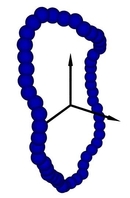The shape of semiflexible polymer rings
Karen Alim and Erwin Frey
 Following the trajectory of a random walk or likewise a flexible polymer one finds that the typical overall shape is cigar-like, prolate. Intuitively one would assume a spherical appearance, but this implies rotational averaging. Flexible and moreover semiflexible polymers are the building blocks of various biological processes, since DNA and cytoskeletal filaments belong to the class of semiflexible polymers. The shape of a polymer is important for its mobility in heterogeneous media like the cytoplasm, the depletion forces between larger complexes in polymer solution or the accessibility of specific sites along the polymer to enzymes.
Following the trajectory of a random walk or likewise a flexible polymer one finds that the typical overall shape is cigar-like, prolate. Intuitively one would assume a spherical appearance, but this implies rotational averaging. Flexible and moreover semiflexible polymers are the building blocks of various biological processes, since DNA and cytoskeletal filaments belong to the class of semiflexible polymers. The shape of a polymer is important for its mobility in heterogeneous media like the cytoplasm, the depletion forces between larger complexes in polymer solution or the accessibility of specific sites along the polymer to enzymes.
 Our recent work shows that semiflexible polymer rings such as DNA plasmids or viral DNA exhibit distinct shapes depending on their flexibility. Stiff rings are planar ``ellipses'' while flexible rings have three dimensional crumpled configurations. To determine the shape we performed Monte Carlo simulations and measured the joint distribution and the mean of the asphericity (the deviation from spherical symmetry) and the nature of asphericity (the degree of prolate-or oblateness). In both the stiff and the flexible limit analytic calculations explain the observed behavior.
Our recent work shows that semiflexible polymer rings such as DNA plasmids or viral DNA exhibit distinct shapes depending on their flexibility. Stiff rings are planar ``ellipses'' while flexible rings have three dimensional crumpled configurations. To determine the shape we performed Monte Carlo simulations and measured the joint distribution and the mean of the asphericity (the deviation from spherical symmetry) and the nature of asphericity (the degree of prolate-or oblateness). In both the stiff and the flexible limit analytic calculations explain the observed behavior.

